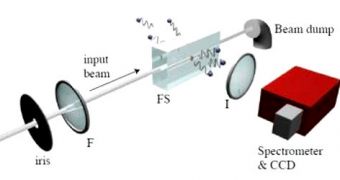Physicists believe that they may have finally discovered the first signs of artificially-produced Hawking radiation, in a series of experiments that was carried out in Italy. Experts have in effect created an optical analog for the elusive form of radiation, that was hypothesized by famed physicist Stephen Hawking.
Following his proposal, many researchers now believe that black holes should in fact be emitting this form of radiation, which is in fact a type of thermal emission that comes out of these extreme-gravity objects.
It is believed that quantum effects make the black holes released these black body spectrum radiations. Thus far, observing them directly has proven to be harder than anyone anticipated, but new experiments are beginning to provide hopes that the radiation will finally be observed directly.
In this sense, the achievement made by the Italian physics team is remarkable. Becoming able to study potential Hawking radiation using only a piece of glass and a powerful laser could allow them to gain more insight into the nature of the phenomenon.
This could in turn make it a lot easier for other research teams to construct detectors for finding and studying actual Hawking radiations around black holes.
In a paper describing the findings, the experts say that the mathematical equations underlying this experiment are the same as those governing the release of the actual radiation.
Superficially however, there is little the laser experiment has in common with the release of Hawking radiation. Both processes are described by roughly the same set of calculations.
If this study is indeed confirmed to have discovered laser-induced Hawking radiation, then the findings would make a strong case for supporting Hawking's yet-unproven theory.
One of the main issues with his idea is the fact that proposed radiations could be extremely weak. Hawking argues that photons can be spontaneously generated at the edge of black holes, but concedes that this energy can be so weak that it can easily escape detection.
In the past, researchers have tried to emulate the emission of this type of radiation using lasers, but the readings were hampered by the other forms of photons that were produced following the experiments, Space Fellowship reports.
Using a bulk glass target and a tunable laser, the Italian team, led by expert Franco Belgiorno, managed to limit the radiation to certain wavelengths of infrared light. The group then used an infrared camera to image the photons.
Details of their investigation appear in the latest issue of the esteemed scientific journal Physical Review Letters, and are also discussed in a Viewpoint article in this week's issue of the publication Physics.

 14 DAY TRIAL //
14 DAY TRIAL //